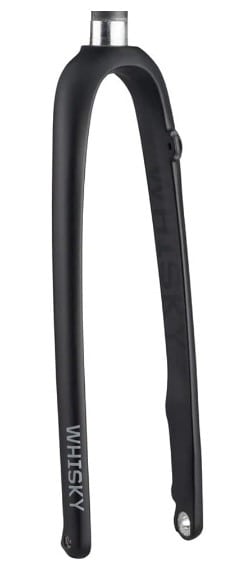At times, things happen so fast that we get lost amid new terminologies. In the cycling world, this is the same case.Notably, rigid and suspension forks are common terms for most folks. But what is a suspension corrected fork?
A suspension corrected fork is a rigid bike fork with a longer measurement from the axle to the crown than standard forks. These forks are designed for bike frames that generally operate with front suspension. The extra length helps retain a bike’s original geometry and handling when you convert it from suspension to rigid forks.

What Is A Suspension Corrected Fork – Is It Better Than A Standard Fork?
As mentioned in the intro above, a suspension corrected fork refers to a lengthened rigid fork that fits in a bicycle that originally had front suspension. All the same, are suspension corrected forks better than suspension forks?
The answer here depends on a cyclists’ riding style. Consequently, most riders prefer going for suspension corrected forks because of reasons such as:
They Are Reliable
First, suspension forks are susceptible to mechanical failures. At times, they get leaky, and this compromises their functionality. Still, what if they failed on a day when you have ridden away from the city?As for the rigid forks, you don’t have to worry much about them failing. Though they are not fail-proof, suspension corrected forks are more reliable than their suspension counterparts.
In fact, this is the reason why off-road touring bikes use rigid forks to date.
Lightweight And Better Control
Also, suspension corrected forks feel lighter, and they make bike handling easier than when it has a front suspension. As a result, rigid bikes are the best choice for beginners, and pro riders also appreciate the simplicity of suspension corrected forks. Actually, if most of your riding happens on the city roads, you should try going rigid.
One of the best suspension corrected forks is the WHISKY – No.9 Carbon Fiber Cyclocross Bike Fork. It is lightweight, strong, and fits up to 700 × 42c road tire or 650 × 50c tires. It is ideal for road or gravel riding.

They Are Cheaper
Suspension corrected forks also happen to be cheaper than suspension forks. Spending less money on forks allows you to spend the extra cash on other necessary components.Also, in matters to do with maintenance costs, rigid forks are cheaper to maintain as compared to suspension forks. This makes it easy for beginners to keep their bikes adequately maintained.
Consequently, suspension corrected forks are ideal for a wide range of riding styles.
Maintains Bike Geometry
For the bike to feel relatively the same, you need to replace the suspension forks with one that will maintain the bike frame’s geometry.Notably, frames designed for front suspension have a slacker head tube angle that keeps the bike stable even when the shocks dip.
In case you replace suspension forks with rigid non-suspension corrected forks, the bike would slant to the front. Unfortunately, this would shift the rider’s weight to the front.
As a result, the bike would become dangerous and hard to control.
Therefore, a suspension corrected fork such as the SOMA 453mm CrMo Mountain Bicycle Disc Fork will maintain your bike’s frame geometry. Use this fork to replace 100mm travel MTB suspension forks. Again, the fork works with universal disc brakes and has a 250mm steerer.
Without a suspension corrected fork, your bike that previously had suspension would look awful and unprofessional.
How To Get A Suspension Corrected Fork’s Length?
How much should a suspension corrected fork measure in length? Ideally, a suspension corrected fork should maintain the bike’s geometry.
Therefore, when choosing a suspension corrected fork, make sure it has the same length as a non-compressed suspension fork. Here is how to get the correct size for your rigid fork.
Measure Axle – Crown Length
To calculate the ideal length of your suspension corrected fork, first measure the uncompressed length from the axle to the fork crown.Notably, this is the distance from the middle of the front wheel axle to the top of the current fork’s crown. Most importantly, ensure that you take the length in a straight line.
Determine The Fork Sag
When you sit on a bike with a front suspension, the fork will slightly compress because of your body weight. That displacement is the fork sag.
Using zip ties (fitted with the teeth facing out), you can get how much your shocks sag. Loop the ties around the stanchions and let them sit on the fork seals.
Afterward, get on the bike and place the center of your mass in the middle (out of the saddle). Then, Alight from the cycle without leaning on the handlebars.
Finally, measure the distance from the shock seal to the new position of the zip-tie. That’s the sag.
Calculate The Suspension Corrected Fork Length
Once you have the sag and the distance between the axle and the fork crown, you can now calculate the length of your suspension corrected fork.You get your ideal fork length by subtracting the sag from the axle-crown length.
For example, if the suspension fork axle – crown length is 500mm and the sag is 45mm, then your suspension corrected fork length should be about 455mm.
Thus, the number you get is your approximate length of the suspension corrected fork from the axle to the crown.
Can I Put A Suspension Corrected Fork On My Bike?
After all, having gone through the demystification of a suspension corrected fork, you need to decide. Should you go for a suspension corrected or stay with the standard fork.
First, you need to consider your riding style. Are you a full-time off-road rider, or are you a city road enthusiast?
If you mostly ride on rugged roads, having your front suspension could come with lots of relief. All the same, if your trail isn’t so bumpy, you may swap the shocks for the rigid forks.
On the other hand, if your bike trips are almost always on the asphalt roads, getting a few pounds off your bike isn’t a bad idea.
Furthermore, even when you go temporarily off-road, riding on the rigid fork shouldn’t be a problem.
Does The Bicycle Frame Matter?
Different bike frames suit different riding styles. For example, cross country race bike can accommodate about 100mm – 120mm travel, while a city bike work with about 40mm to 80mm.
Unfortunately, fitting a longer fork could potentially damage the head tube. On the other hand, installing a shorter corrected fork could adversely affect the bike’s geometry.
Consequently, when changing a suspension fork for a rigid one, you need to fit a suspension corrected fork that won’t hurt your head tube or bike geometry.
All the same, for a 26″ mountain bike, a fork like the Pyramid Sunlite 26″ MTB Fork should work well. It works well with 26″ MTB and has a 200mm steer tube. Also, it features a uni-crown and has threads up to 120mm.
Also Read: Can I raise my bike handlebars?
In Summary
When you want to swap from a suspension to a rigid bike, you need a suspension corrected fork. In essence, these types of forks are longer to preserve the initial geometry and ease of handling a bicycle that had suspension forks.
If you happen to install a non-suspension corrected fork in place of one that has the shocks, you might end up with a bike that is slanting forward.
This doesn’t make the bike only hard to handle, but it also becomes dangerous to ride, especially when riding down a steep slope.
Therefore, you need to do some little homework and get the corresponding fork length before buying one.